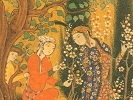
Sacred Texts Islam Index Previous Next
Buy this Book on Kindle


Selections from the Poetry of the Afghans, by H.G. Raverty, [1868], at sacred-texts.com
Mullā Æabd-ur-Raḥmān is one of the most popular, and probably the best known, of all the Afghān poets. His effusions are of a religious or moral character, and chiefly on the subject of divine love, being, like the poetical compositions of all Muḥammadan poets, tinged with the mysticisms of Ṣūfi-ism, already described in the Introductory Remarks; but there is a fiery energy in his style, and a natural simplicity, which will be vainly sought for amongst the more flowery and bombastic poetry of the Persians.
Raḥmān belonged to the Ghorīah Khel clan or sub-division, of the Mohmand tribe of the Afghāns, and dwelt in the village of Hazār-Khānī, in the tapah or district of the Mohmands, one of the five divisions of the province of Pes’hāwar. He was a man of considerable learning, but lived the life of a Darwesh, absorbed in religious contemplation, and separated from the world, with which, and with its people, he held no greater intercourse than necessity and the means of subsistence demanded. He is said to have been passionately fond of hearing religious songs, accompanied by some musical instrument, which the Chastī sect of Muḥammadans * appears to have a great partiality for. After a time, when the gift of poesy was bestowed upon him, he became a strict recluse,
and was generally found by his friends in tears. Indeed, he is said to have been in the habit of weeping so much, as in course of time to have produced wounds on both his cheeks. His strict retirement, however, gave opportunity to a number of envious Mullās to belie him; and they began to circulate reports to the effect, that Raḥmān had turned atheist or heretic, since he never left his dwelling, and had even given up worshipping at the mosque along with the congregation—a matter strictly enjoined on all orthodox Muḥammadans. At length, by the advice and assistance of some of the priesthood, more liberal and less bigoted than his enemies, he contrived to escape from their hands, by agreeing, for the future, to attend the place of public worship, and to pray and perform his other religious duties, along with the members of the congregation. He thus, whether agreeable to himself or not, was obliged in some measure to mix with the world; and this, doubtless, gave rise to the ode at page 29, to which the reader is referred.
Raḥmān appears to have been in the habit of giving the copies of his poems, as he composed. them, from time to time, to his particular friends, which they, unknown to each other, took care to collect and preserve, for the express purpose of making a collection of them after the author's death. This they accordingly carried out, and it was not until Raḥmān's decease that these facts became known. It then appeared also, that some of these pseudo friends had, to increase the bulk of their own collection of the poet's odes, mixed up a quantity of their own trashy compositions with Raḥmān's, and had added, or rather forged, his name to them in the last couplets. In this manner two of these collections of odes were made, and were styled Raḥmān's first and second. Fortunately for his reputation, these forgeries were discovered in time, by some of the dearest of the poet's friends, who recognised or remembered the particular poems of his composition;
and they accordingly rejected the chaff, retaining the wheat only, in the shape of his Dīwān, or alphabetical collection of odes, as it has come down to the present day. Still, considerable differences exist in many copies, some odes having a line more or a line less, whilst some again contain odes that are entirely wanting in others. This caused me considerable trouble when preparing several of them for insertion in my "Selections in the Afghān Language;" but it was attended with a proportionate degree of advantage, having altogether compared some sixty different copies of the poet's works, of various dates, some of which were written shortly after Raḥmān's death, when his friends had succeeded in collecting the poems in a single volume.
By some accounts, the poet would appear to have been a co-temporary of the warrior-poet, Khushḥāl Khān; * and it has been stated, that on two or three occasions they held poetical disputations together. This, however, cannot be true; for it seems that although Raḥmān was living towards the latter part of that brave chieftain's life, yet he was a mere youth, and was, more correctly speaking, a cotemporary of Afẓal Khān's, the grandson and successor of Khushḥāl, and the author of that rare, excellent, and extensive Afghān history, entitled, "Tārīkh-i-Muraṣṣaæ," and other valuable works. A proof of the incorrectness of this statement is, that the tragical end of Gul Khān and Jamal Khān, which Raḥmān and the poet Ḥamīd also have devoted a long poem to, † took place in the year of the Hijrah 1123 (a.d. 1711), twenty-five years after the death of Khushḥāl. Another, and still stronger proof against the statement of poetical disputations having taken place between them, is the fact of Raḥmān's retired life, and his humble position, as compared with that of Khushḥāl, the chief of a powerful tribe, and as good a poet as himself.
Some descendants of Raḥmān, on his daughter's side, dwell at present in the little hamlet of Deh-i-Bahādur (the Hamlet of the Brave), in the Mohmand district; but the descendants on the side of his only son have long been extinct.
The poet's tomb may still be seen in the graveyard of his native village.
1:* So called from a celebrated devotee named Muæīn-ud-Dīn, who dwelt at a place named Chast, in Arabia. The sect still exists in Afghānistān and the Panjāb.
3:* See Memoir preceding his poems.
3:† See Ḥamīd, Poem XLI. and note.
SIGN UP!!! CLICK HERE TO GET 52 BOOKS FREE!!

SIGN UP!! FOR BOOKS AND REGULAR ARTICLES
https://againstsatanism.com/Prices.htm
HOW TO DEFEAT SATANISM AND LUCIFERIANISM AND BOOST YOUR EVOLUTION THROUGH ENERGY ENHANCEMENT MEDITATION "I have experience of many forms of meditation and practices for self improvement including: Transcendental meditation (TM) 12 years, Kriya Yoga 9 years, Sushila Buddhi Dharma (SUBUD) 7 years, and more recently the Sedona Method and the Course in Miracles.
The Energy Enhancement programme encapsulates and expands all of these systems, it is complete and no questions are left unanswered."
Energy Enhancement Level 0 Super Chi Prana, Power, Strength, Immortality
https://www.energyenhancement.org/LEVEL-Energy-Enhancement-Super-Chi-Immortality-Prana-Meditation-Course.htm
Energy
Enhancement Meditation LEVEL 1 Immortality - Activate the Antahkarana! Gain
Infinite Energy from the Chakras above the Head - Power UP!! Open Your Third
Eye, Gain Super Samadhi Kundalini Alchemical VITRIOL Energy. Ground All Negative
Energies. Access Quantum Immortality
Energy
Enhancement Meditation LEVEL 2 - The Energy Enhancement Seven Step Process to Totally
Remove Energy Blockages, Totally Remove All
Problems, Totally Remove Negative Emotions, Heal Your DNA, Remove your Karma -
OPEN YOUR LIFE!!
Energy
Enhancement Meditation LEVEL 3 - Eliminate even Deeper Energy Blockages - The
Removal of Strategies. Quantum Integration. The Karma Cleaning Process to
Totally Eliminate All Your Karma, all your Trauma, all your Energy Blockages
from All your Past Lifetimes!!
https://www.energyenhancement.org/Level3.htm
Energy
Enhancement Meditation LEVEL 4 - Stop the Suck!! Heal All your Relationships!! Find Your
Twin Flame!! MASTER ENERGY CONNECTIONS AND
RELATIONSHIPS
OUR SPECIAL MEDITATION REVOLUTION OFFER!!
WE HAVE THE TECHNOLOGY
WE CAN REMOVE YOUR ENERGY BLOCKAGES, ENTITIES AND DEMONS
WE CAN RE-BUILD YOU..